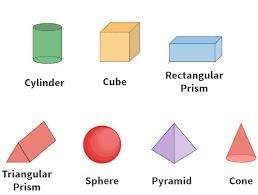Class 8 Exam > Class 8 Notes > Year 8 Mathematics IGCSE (Cambridge) > Shapes, Area, and Volume
Shapes, Area, and Volume | Year 8 Mathematics IGCSE (Cambridge) - Class 8 PDF Download
Understanding Shapes
- Shapes can be categorized into 2D and 3D shapes.
- 2D Shapes: These shapes lie flat on a plane and include triangles, squares, rectangles, circles, and polygons.
- Example: A rectangle has four right angles and opposite sides that are equal in length.
- 3D Shapes: These shapes have depth and include cubes, cuboids, spheres, cones, and pyramids.
- Example: A cube has six faces that are all squares of equal size.

Calculating Area
- 2D Shapes Area: Area is the space inside a shape, measured in square units (e.g., square centimeters).
- Example: The area of a rectangle is calculated using the formula: Area = length × width.
- 3D Shapes Surface Area: Surface area is the total area of all the surfaces of a 3D shape.
- Example: The surface area of a cube is 6 × side2, where side is the length of one edge.
Calculating Volume
- 3D Shapes Volume: Volume is the amount of space a 3D shape occupies, measured in cubic units (e.g., cubic centimeters).
- Example: The volume of a cuboid is calculated using the formula: Volume = length × width × height.
- Calculating Sphere Volume: The volume of a sphere is
 where r is the radius.
where r is the radius.
Real-World Applications
- Engineering and Architecture: Understanding shapes, area, and volume helps in designing buildings, bridges, and other structures.
- Daily Life: Calculating area helps in laying tiles or carpeting rooms, while volume calculations are used in packaging and container design.
The document Shapes, Area, and Volume | Year 8 Mathematics IGCSE (Cambridge) - Class 8 is a part of the Class 8 Course Year 8 Mathematics IGCSE (Cambridge).
All you need of Class 8 at this link: Class 8
|
42 videos|62 docs|24 tests
|
FAQs on Shapes, Area, and Volume - Year 8 Mathematics IGCSE (Cambridge) - Class 8
| 1. What are the basic concepts of shapes, area, and volume? |  |
Ans. The basic concepts of shapes, area, and volume include understanding different shapes such as squares, rectangles, circles, triangles, and cubes, calculating the area of 2D shapes, and finding the volume of 3D shapes.
| 2. How do you calculate the area of a shape? |  |
Ans. The area of a shape can be calculated by multiplying the length by the width for rectangles, using the formula πr^2 for circles, and using 1/2 x base x height for triangles.
| 3. What is the difference between area and volume? |  |
Ans. Area refers to the amount of space a 2D shape covers, while volume refers to the amount of space a 3D shape occupies. Area is measured in square units (such as square meters), while volume is measured in cubic units (such as cubic meters).
| 4. How is volume calculated for different 3D shapes? |  |
Ans. The volume of a cube or rectangular prism is calculated by multiplying the length by the width by the height. The volume of a cylinder is found using the formula πr^2h, where r is the radius and h is the height. The volume of a sphere is calculated using the formula 4/3πr^3, where r is the radius.
| 5. Can the concepts of shapes, area, and volume be applied in real-life situations? |  |
Ans. Yes, the concepts of shapes, area, and volume are used in various real-life situations such as calculating the amount of paint needed to cover a wall, determining the capacity of a container, or designing buildings and structures.
Related Searches




















